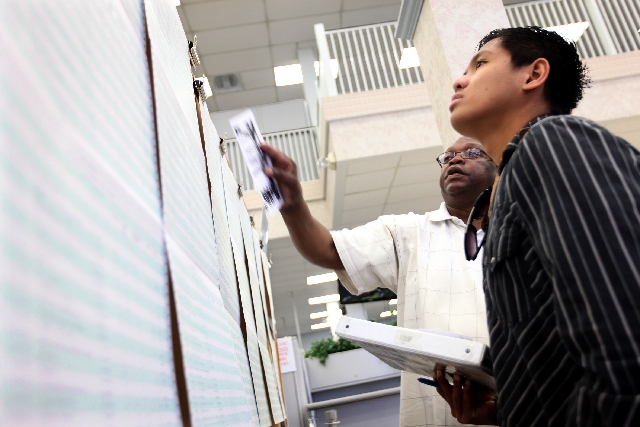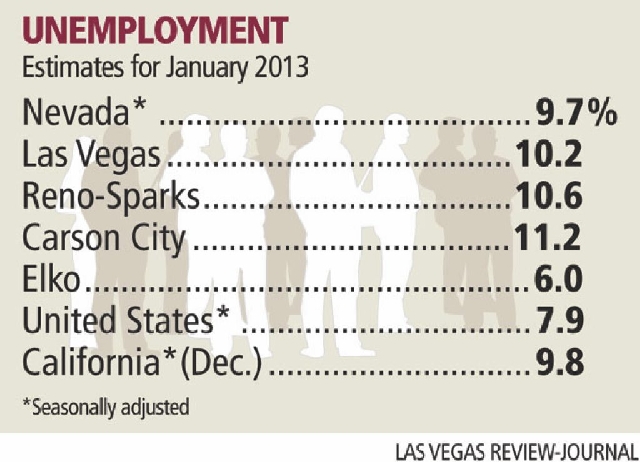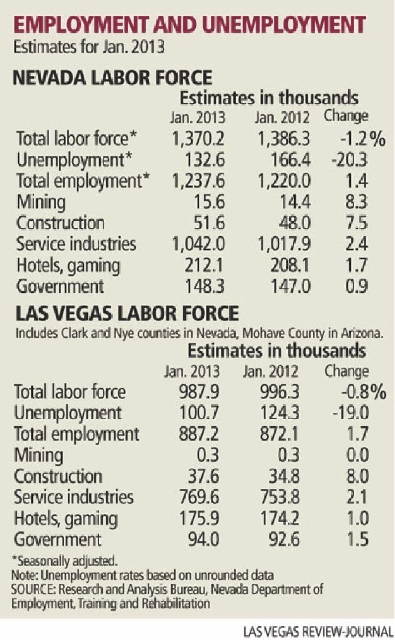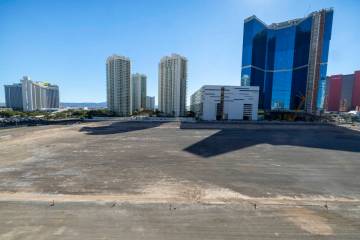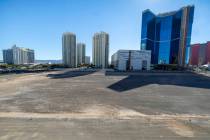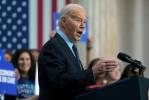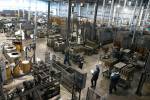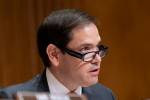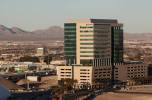Nevada unemployment numbers fall; state no longer leads nation in joblessness
Go ahead. Celebrate.
Just not too much.
Nevada’s jobs economy crossed important psychological barriers in December and January, shedding stigma the way locals shrugged off sweaters amid the week’s heat wave.
Yet, just as it’s important to remember it’s still winter, it’s important to note that the recession hasn’t completely relinquished its grip on state labor markets.
Sure, newly adjusted numbers from the state Department of Employment, Training and Rehabilitation revealed Friday that unemployment fell to single digits in December for the first time since February 2009 — a big surprise for economists who predicted we would spend most or all of 2013 above 10 percent.
Plus, the latest figures show that in December Nevada stopped leading the nation in unemployment. The Silver State fell behind Rhode Island after relinquishing the top spot for the first time since February 2010.
What’s more, January brought the 18th straight month of jobless declines. In all, 132,600 people, including 100,700 Las Vegans, were out of work and looking, down from highs of 197,600 statewide and 144,700 locally in 2010 and 2011.
On the flip-side, Nevada’s unemployment rate is still more than double what it was before the recession’s 2007 start.
To make sense of what the latest numbers really say about our economy, start with why things improved.
SECOND PLACE IS BETTER
Many of the gains in December and January came from adjusting state data against U.S. Bureau of Labor Statistics national numbers. Such benchmarking pushed 2012’s jobless average from early estimates of 11.6 percent down to 11.1 percent, said Bill Anderson, chief economist of the employment department. That means job growth was better than initially thought, and December’s jobless average fell to 9.7 percent, beating an estimate of more than 10 percent.
It’s typical to under-count jobs early in a recovery, said Steve Brown, director of UNLV’s Center for Business and Economic Research. The Bureau of Labor Statistics gets jobs numbers from surveys of households and businesses, and it’s easy to miss startup firms and newly relocated residents.
Friday’s statistics also demonstrate that Nevada’s job-formation rate of 2.5 percent from January 2012 to January 2013 handily beat national growth of
1.5 percent in the same period, a trend driven in part by record visitor volume in Las Vegas, Anderson said. From November to January, job growth averaged 2.3 percent, with more than 6,000 jobs added each month. The state added 28,800 jobs year over year in January.
In fact, Nevada is nearly back in the top 20 states for job growth, Brown said.
Still, job creation was uneven from December to January. Sectors adding jobs included leisure and hospitality, up 4,200; trade, transportation and utilities, up 2,000; and government, up 1,500. The worst-performing sectors were professional and business services, such as accountants and law firms, which shed 900 jobs; construction, which lost 500 positions; and education and health services, down 300 jobs.
The state’s labor markets also shrank in January, as workers left the labor force and no longer counted in the numbers. Roughly 16,000 fewer people were unemployed and looking for work in Nevada year over year in January. That was a decline of 1.2 percent in the labor force, which now stands at 1.37 million.
Put it all together, and Nevada has light-years to go before it returns to pre-recession job levels. The state lost
14.1 percent of its jobs base, about 170,000 jobs, and has recovered just
30 percent of those cut positions, Brown said. Las Vegas has gotten back just
29 percent of what it lost in the downturn. The nation, on the other hand, has gained back roughly two-thirds of its lost jobs.
That means tens of thousands of locals still struggle to find work.
Renato McCallum, 23, has been searching for six months since he moved to Las Vegas from Utah. As he studied job postings Friday afternoon at the employment department’s Nevada JobConnect office on Maryland Parkway, McCallum said it’s hard to see much improvement. He has experience working the cash register and food-prep counter inside fast-food restaurants, and he is looking for a restaurant, gardening or warehouse position. He guesses he has applied for more than 20 jobs, and so far, nothing. Even his friends who find work are landing seasonal temporary jobs, rather than full-time, permanent work.
“I don’t see things getting better, but hopefully, by the end of April, I’ll have a job,” McCallum said. “It’s hard right now, but I’ve just got to keep trying.”
Added McCallum’s dad, Melvin, who drove his son to JobConnect: “I do see things improving, but it’s been harder than it should be for people in his age group. He’s competing with baby boomers. You have Ph.Ds trying to get jobs with McDonald’s. It’s unheard of.”
The employment department doesn’t track employment by age, but the Census Bureau put joblessness among 20- to 24-year-olds at 13.3 percent in 2012.
For Anthony Ware, 34, the problem isn’t his age as much as it is his pay range. Ware, also at JobConnect on Friday, lost his job with a locomotive repair company in December. It has been hard to find anything that comes close to the $21 an hour he earned; much of what’s available pays $7 to $10 an hour, and Ware said it would be hard to support his family on that. So Ware, who is looking for something in aerospace or aircraft maintenance, may move back to Arizona, where he once worked for the Air Force. He said he is optimistic things will work out.
“I’ve been blessed to have a job my whole adult life, so I don’t expect to be out of work for long,” he said. “You’ve just got to work hard and do your best to succeed.”
Opportunities to succeed could be mixed in coming months for McCallum, Ware and other job hunters.
UNCERTAINTY AHEAD
Expect volatility in jobs numbers in the months ahead, experts said.
Potential influences include discouraged workers, construction’s recovery and the national economy.
Take discouraged workers. As they leave the labor force, they are no longer counted in the official rate. But as jobs come back, so will people who quit the labor pool. Unemployment numbers could start to tick up even as employers add jobs. Plus, census numbers released Thursday show the nation’s westward population migration, halted by recession as underwater properties chained down homeowners, has begun again.
Forty of the 50 fastest-growing metro areas in 2012 were in the South or West. Clark County added 19,000 new residents in 2012, its best showing since 2008, to officially surpass 2 million for the first time. As people move here, the labor force could expand and push up joblessness.
Recovery will need an assist from the construction sector. To see how much the industry affected joblessness in Nevada, consider that job losses across all occupations averaged 15 percent, while cuts to the state’s construction work force totaled 60 percent. Remove construction and government from jobless numbers, and state unemployment would have been roughly 7.4 percent in December, said Jeremy Aguero, of local research firm Applied Analysis.
The industry’s 500-job loss in January was better than the 2,000 to 3,000 jobs cut monthly in worse times, but it came even as $2 billion in developments, including Caesars Entertainment’s Linq retail project, were under way on the Strip. But with Genting Group’s planned Resorts World Las Vegas and SBE Entertainment’s transformation of the Sahara into the SLS Las Vegas, construction’s fortunes could change. If building starts to bounce back noticeably, local joblessness could drop to around 8 percent by the end of 2013, Aguero said.
Include part-timers who would rather work full-time and discouraged workers who have quit seeking jobs, and Nevada’s unemployment rate averaged 20.3 percent in 2012, according to the U.S. Bureau of Labor Statistics.




